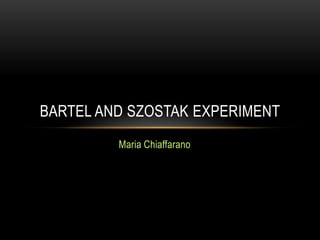Biology bartel and szostak experiment
- 1. Maria ChiaffaranoBartel and Szostak Experiment
- 2. HOW DID LIFE BEGIN?
- 3. Four Overlapping StagesScientists used four stages to understand the origin of life Stage 1 Nucleotides and amino acids were produced prior to the existence of cellsStage 2Nucleotides became polymerized to form RNA and/or DNA and amino acids become polymerized to form proteinsStage 3Polymers became enclosed in membranesStage 4 Polymers enclosed in membranes acquired cellular properties
- 4. Chemical SelectionWhat is chemical selection? Chemical within a mixture has special advantageous properties Properties allow it to increase in amount Hypothesis The cellular characteristics that exist today evolved from an ŌĆ£RNA worldŌĆØ
- 5. RNA WorldScientists believe that the world used to consist of RNA based organisms Studied the building blocks Amino acids and nucleotides
- 6. Key Functions of RNARNA has three key functions that encourage scientists to favor it as the first macromolecule found in protobiontsAbility to store information in its nucleotidesNucleotide sequence has the capacity for self-replication RNA has many enzymatic functions Act as ribozymes
- 7. ADDITIONAL ADVANTAGES OF RNADNA and proteins are not as versatile as RNA DNA has limited catalytic activity Proteins do not undergo self-replication However:RNA can perform functions that are characteristics of proteins while simultaneously serving as genetic material with replicative and informational functions
- 8. Bartel and Szostak ExperimentDavid Bartel and Jack SzostakFirst study that used RNA molecules with a particular function (1993)Synthesized a mixture of 10^15 RNA molecules also known as ŌĆ£long RNAŌĆØ First region (5ŌĆÖ end) constant region among all ŌĆ£long RNAsŌĆØ (identical) Second region, variable region (220 nucleotides) Hypothesized that the variable region could possibly result in long RNA with the enzymatic ability to catalyze a covalent bond between two adjacent nucleotides
- 9. MaterialsMany copies of short RNA Had a tag sequence that binds tightly to ŌĆ£beadsŌĆØ (column packing material) Had a complementary sequence to a site in the constant region of the long RNA No variable region, all the sameLong RNAs with the constant and variable regions Variable regions were made using a PCR step (caused mutations in the region)
- 10. Overview of the experiment
- 11. Step 1The long RNAs and short RNAs were incubated together Promote hydrogen bondingTime was given for the molecules to form covalent connections (only if the RNA had the enzymatic ability to form covalent bonds) The long RNA molecule variable regions may rarely have enzymatic ability to connect the 3ŌĆÖend of short RNA to 5ŌĆÖend of long RNA
- 13. Step 2The mixture passed through a column of beads The beads would bind to the tag sequence of the short RNA only! Tag sequence promoted the binding of the short RNA to the beadsIF the long RNA had the ability to bind to the short RNA, it would also be attached to the beads Additional liquid was added to filter out the long RNAs that did not covalently bond to the short RNAs
- 14. Step 3 The main purpose of this step was to get rid of the beadsLow pH solution was added in order to prevent the tag sequence from binding to the beads The tightly bound RNAs are flushed out of the column They were flushed into a flask and labeled ŌĆ£Pool #1ŌĆØ Beads were left behind
- 15. Step 4Pool #1 was used to make a second batch of long RNA molecules Polymerase chain reaction (PCR) was usedVariable regions were derived from the variable regions of pool #1 RNA molecules, expected to have enzymatic activity Reverse transcriptase was used to make cDNAPCR primers recognized beginning and end of the long RNA sequence and copied only this region cDNA used as a template to make long RNA via RNA polymerase
- 16. Steps 5 & 6The procedure was repeated in order to generate 10 consecutive pools of RNA molecules A sample of the original population (Pool #1) and each of the following 10 pools were collected in order to test for the enzymatic ability to catalyze a covalent bond between adjacent nucleotides
- 18. ConclusionData:Chemical selection is possibleScientists knew this because the experiment showed that there was an increase in covalent bond formation from pool 1 to pool 10 In each generation, the catalytic enzyme activity increased Pool #10ŌĆÖs enzymatic activity was approximately 3 million times higher than the original random pool of molecules


















